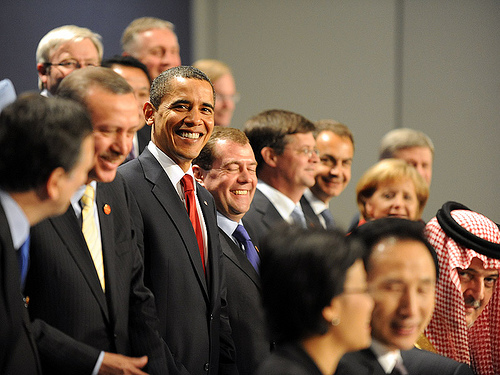Mahendra Siregar, the Indonesian Deputy Minister of Trade, said during an EABER-SABER conference in February 2010, that the ‘G20 can be an international forum for structural reforms’. His words highlight the role that the G20 could play globally, especially in promoting growth in emerging economies.
Constraints caused by border barriers to trade have been lowered over the years by international trade agreements , but ‘behind the border’ reforms remain a crucial issue. They include reforms of economic and legal structures, regulatory frameworks, competitiveness policy, bureaucracy and governance. One issue such reforms must aim to address is the need for intra-regional trade growth, particularly since the region’s trade dependent economies will face the new challenge of the weakening European and US markets.
Additionally, a concrete reform agenda is needed to foster national resilience. This would include a social safety net, funding for health care and education and green policies. Structural reform will thus be important in maintaining the global economic growth momentum coming from the East Asian Pacific region and other emerging countries.
Structural reforms are politically sensitive matters in which international commitment, compliance and pressures might help on many fronts, including environmental issues. This was evident in the recent resignation of the Indonesian Minister of Finance, well known as one of the top Indonesian reformists and technocrats. Her uncompromisable actions of reforms, including on top political and business elites, lost supports from the President, who favored political stability over anything else.
Structural reforms are not new words in the context of rebalancing strategies for those who may have read Huang’s factor market cost distortions hypothesis in China (2010). Referred by Soesastro (2009) as ‘second generation reforms’, structural reforms need to be discussed at the high political table not only because of the nature of the reforms that need political commitment and international support, but also because domestic structural reforms are indispensible to maintain a strong, sustainable, and balanced global economic growth.
The commitments to structural reforms by the G20 countries are already in place to some extent. Indonesia’s G20 framework template, for example, consists of three main elements, namely (1) monetary policy, (2) fiscal policy, and (3) structural reforms (including bureaucratic reforms and governance). The implementation might be messy, but regional arrangements could help. As Soesastro (2009) put it: ‘The new global economic governance structure will need to be based on representative institutions.’ Regional institutions and arrangements , such as the new ASEAN+3 Macroeconomic Research Office, should be the organs of reform and actions through the G20. Only when regional institutions and global institutions are synchronized, can domestic reforms be successful. A survey of leaders’ opinions that was conducted in the Asia and Pacific regions by the ADB (2010) suggests that we should not reinvent the wheel, but strengthen and consolidate the existing regional institutions, including the CMIM arrangement and ASEAN+3 independent regional surveillance arrangement.
It would be wrong to put APEC and G20 in the same landscape, but it is worth considering how G20 can be an international forum for developing structural reform in the post LAISR period (APEC’s Leaders’ Agenda for Structural Reform expires in 2010) by making structural reform its medium and long term agenda. Structural reforms will also strengthen domestic microeconomic sectors that are not irrelevant to macroeconomic stability and national resilience.
There are four main agenda items that should be included in this year’s G20 Summit: macroeconomic stability, financial reforms, rebalancing the global imbalance, and international financial institutions reforms. We had hoped to discuss the first two agenda categories during the Toronto summit in June and the latter two during the Seoul summit in November.
Unfortunately, due to the Greek crisis the Toronto agenda is likely to take a ‘detour’ to accommodate the global concerns of a double-dip coming out from Europe. The Seoul G20 Summit, however, must not be overshadowed by the ongoing crisis in Europe. It must stick to the ‘Asian agenda’ of structural and related reforms and adopt a ‘beyond the crisis’ focus. East Asian and Pacific countries must lead: they should set the tone for discussions and pick up the momentum for reform. This is a golden opportunity for the East Asian and Pacific countries to contribute to the global economic recovery.
Maria Wihardja is an Associate Fellow at the Centre of Strategic and International Studies, Jakarta.

